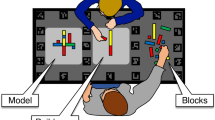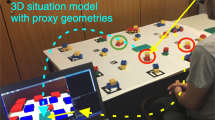Abstract
Given the importance of gaze in Human-Robot Interactions (HRI), many gaze control models have been developed. However, these models are mostly built for dyadic face-to-face interaction. Gaze control models for multiparty interaction are more scarce. We here propose and evaluate data-driven gaze control models for a robot game animator in a three-party interaction. More precisely, we used Long Short-Term Memory networks to predict gaze target and context-aware head movements given robot’s communication intents and observed activities of its human partners. After comparing objective performance of our data-driven model with a baseline and ground truth data, an online audiovisual perception study was conducted to compare the acceptability of these control models in comparison with low-anchor incongruent speech and gaze sequences driving the Furhat robot. The results show that our data-driven prediction of gaze targets is viable, but that third-party raters are not so sensitive to controls with congruent head movements.
Access this chapter
Tax calculation will be finalised at checkout
Purchases are for personal use only
Similar content being viewed by others

Notes
References
Admoni, H., Scassellati, B.: Social eye gaze in human-robot interaction: a review. J. Hum.-Robot Interact. Steering Committee 6(1), 25–63 (2017)
Al Moubayed, S., Beskow, J., Skantze, G., Granström, B.: Furhat: a back-projected human-like robot head for multiparty human-machine interaction. Int. J. Humanoid Rob. 2021, 1–11 (2013)
Aliasghari, P., Taheri, A., Meghdari, A.F., Maghsoodi, E.: Implementing a gaze control system on a social robot in multi-person interactions. SN Appl. Sci. 2, 1–13 (2020)
Birdwhistell, R.L.: Background to kinesics. ETC Rev. General Semant. 13(1), 10–18 (1955)
Cambuzat, R., Elisei, F., Bailly, G., Simonin, O., Spalanzani, A.: Immersive teleoperation of the eye gaze of social robots assessing gaze-contingent control of vergence, yaw and pitch of robotic eyes. In: ISR 2018–50th International Symposium on Robotics, pp. 232–239. VDE, Munich (2018)
Correia, F., Campos, J., Melo, F., Paiva, A.: Robotic gaze responsiveness in multiparty teamwork. Int. J. Soc. Robot. 15, 27–36 (2022)
Freedman, E., Sparks, D.: Coordination of the eyes and head: movement kinematics. Exp. Brain Res. 131, 22–32 (2000)
Fuller, J.H.: Comparison of Head Movement Strategies among Mammals. In: The Head-Neck Sensory Motor System. Oxford University Press (1992)
Fuller, J.H.: Head movement propensity. Exp. Brain Res. 92, 152–164 (2004)
Gillet, S., Cumbal, R., Pereira, A., Lopes, J., Engwall, O., Leite, I.: Robot gaze can mediate participation imbalance in groups with different skill levels. In: Proceedings of the 2021 ACM/IEEE International Conference on Human-Robot Interaction, pp. 303–311. Association for Computing Machinery, New York (2021)
Haefflinger, L., Elisei, F., Gerber, S., Bouchot, B., Vigne, J.P., Bailly, G.: On the benefit of independent control of head and eye movements of a social robot for multiparty human-robot interaction. In: Kurosu, M., Hashizume, A. (eds.) Human-Computer Interaction. LNCS, vol. 14011, pp. 450–466. Springer, Cham (2023). https://doi.org/10.1007/978-3-031-35596-7_29
Huang, H.H., Kimura, S., Kuwabara, K., Nishida, T.: Generation of head movements of a robot using multimodal features of peer participants in group discussion conversation. Multimodal Technol. Interact. 4(2), 15 (2020)
Ishii, R., Otsuka, K., Kumano, S., Yamato, J.: Predicting who will be the next speaker and when in multi-party meetings. NTT Tech. Rev. 13, 07 (2015)
Itti, L., Dhavale, N., Pighin, F.: Photorealistic attention-based gaze animation. In: 2006 IEEE International Conference on Multimedia and Expo, pp. 521–524 (2006)
Jonell, P., Yoon, Y., Wolfert, P., Kucherenko, T., Henter, G.E.: HEMVIP: human evaluation of multiple videos in parallel. In: Proceedings of the 2021 International Conference on Multimodal Interaction, pp. 707–711. Association for Computing Machinery, New York (2021)
Kendon, A.: Some functions of gaze-direction in social interaction. Acta Physiol. (Oxf) 26(1), 22–63 (1967)
Kingma, D., Ba, J.: Adam: a method for stochastic optimization. In: International Conference on Learning Representations (2014)
Kuno, Y., Sadazuka, K., Kawashima, M., Yamazaki, K., Yamazaki, A., Kuzuoka, H.: Museum guide robot based on sociological interaction analysis. In: CHI 2007, pp. 1191–1194. Association for Computing Machinery, New York (2007)
Metta, G., et al.: The iCub humanoid robot: an open-systems platform for research in cognitive development. Neural Netw. 23(8), 1125–1134 (2010)
Mishra, C., Skantze, G.: Knowing where to look: a planning-based architecture to automate the gaze behavior of social robots. In: 2022 31st IEEE International Conference on Robot and Human Interactive Communication (RO-MAN), pp. 1201–1208. IEEE Press (2022)
Mutlu, B., Kanda, T., Forlizzi, J., Hodgins, J., Ishiguro, H.: Conversational gaze mechanisms for humanlike robots. ACM Trans. Interact. Intell. Syst. 1(2), 1–33 (2012)
Mutlu, B., Shiwa, T., Kanda, T., Ishiguro, H., Hagita, N.: Footing in human-robot conversations: How robots might shape participant roles using gaze cues. In: Proceedings of the 4th ACM/IEEE International Conference on Human Robot Interaction, pp. 61–68. Association for Computing Machinery (2009)
Nakano, Y.I., Yoshino, T., Yatsushiro, M., Takase, Y.: Generating robot gaze on the basis of participation roles and dominance estimation in multiparty interaction. ACM Trans. Interact. Intell. Syst. 5(4), 1–23 (2015)
Nguyen, D.-C., Bailly, G., Elisei, F.: Comparing cascaded LSTM architectures for generating head motion from speech in task-oriented dialogs. In: Kurosu, M. (ed.) HCI 2018. LNCS, vol. 10903, pp. 164–175. Springer, Cham (2018). https://doi.org/10.1007/978-3-319-91250-9_13
Pereira, A., Oertel, C., Fermoselle, L., Mendelson, J., Gustafson, J.: Effects of different interaction contexts when evaluating gaze models in HRI. In: Proceedings of the 2020 ACM/IEEE International Conference on Human-Robot Interaction, pp. 131–139. Association for Computing Machinery, New York (2020)
Prévot, L., Elisei, F., Bailly, G.: The robotrio corpus (2020). https://hdl.handle.net/11403/robotrio/v1, ORTOLANG (Open Resources and TOols for LANGuage) - www.ortolang.fr
Sacks, H., Schegloff, E., Jefferson, G.: A simple systematic for the organisation of turn taking in conversation. Language 50, 696–735 (1974)
Shintani, T., Ishi, C.T., Ishiguro, H.: Analysis of role-based gaze behaviors and gaze aversions, and implementation of robot’s gaze control for multi-party dialogue. In: HAI 2021, pp. 332–336. Association for Computing Machinery (2021)
Sidner, C.L., Kidd, C.D., Lee, C., Lesh, N.: Where to look: a study of human-robot engagement. In: Proceedings of the 9th International Conference on Intelligent User Interfaces, IUI 2004, pp. 78–84. Association for Computing Machinery, New York (2004)
Skantze, G., Johansson, M., Beskow, J.: Exploring turn-taking cues in multi-party human-robot discussions about objects. In: Proceedings of the 2015 ACM on International Conference on Multimodal Interaction, pp. 67–74. Association for Computing Machinery, New York (2015)
Stefanov, K., Salvi, G., Kontogiorgos, D., Kjellström, H., Beskow, J.: Modeling of human visual attention in multiparty open-world dialogues. J. Hum.-Robot Interact. 8(2), 1–21 (2019)
Vertegaal, R., Slagter, R., van der Veer, G., Nijholt, A.: Eye gaze patterns in conversations: there is more to conversational agents than meets the eyes. In: Proceedings of the SIGCHI Conference on Human Factors in Computing Systems, pp. 301–308. Association for Computing Machinery, New York (2001)
Zangemeister, W., Stark, L.: Types of gaze movement: variable interactions of eye and head movements. Exp. Neurol. 77(3), 563–577 (1982)
Zaraki, A., Mazzei, D., Giuliani, M., de rossi, D.: Designing and evaluating a social gaze-control system for a humanoid robot. IEEE Trans. Syst. Man Cybernet. A Syst. Hum. 44, 157–168 (2014)
Acknowledgements
The RoboTrio corpus was supported by CNRS through a S2IH PEPS funding. This research is supported by the ANR 19-P3IA-0003 MIAI. The first author is financed by a CIFRE PhD granted by ANRT (2021/0836).
Author information
Authors and Affiliations
Corresponding author
Editor information
Editors and Affiliations
Rights and permissions
Copyright information
© 2024 The Author(s), under exclusive license to Springer Nature Singapore Pte Ltd.
About this paper
Cite this paper
Haefflinger, L., Elisei, F., Bouchot, B., Varini, B., Bailly, G. (2024). Data-Driven Generation of Eyes and Head Movements of a Social Robot in Multiparty Conversation. In: Ali, A.A., et al. Social Robotics. ICSR 2023. Lecture Notes in Computer Science(), vol 14453 . Springer, Singapore. https://doi.org/10.1007/978-981-99-8715-3_17
Download citation
DOI: https://doi.org/10.1007/978-981-99-8715-3_17
Published:
Publisher Name: Springer, Singapore
Print ISBN: 978-981-99-8714-6
Online ISBN: 978-981-99-8715-3
eBook Packages: Computer ScienceComputer Science (R0)



